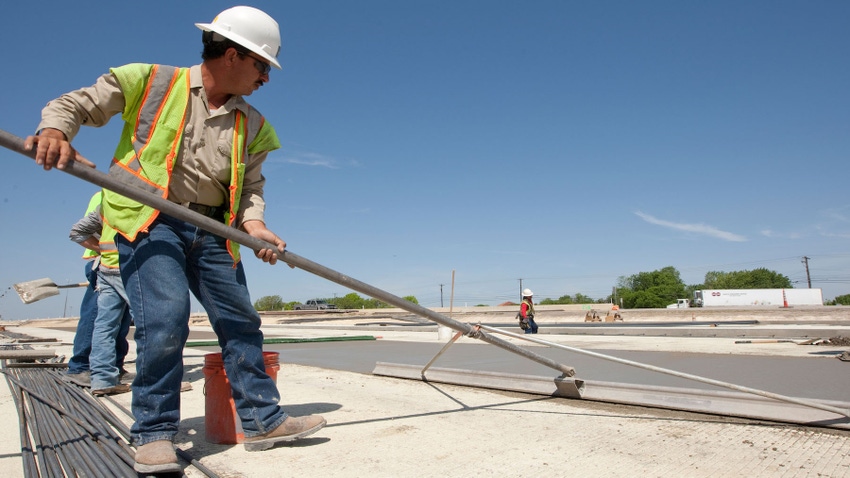How to Construct a Quality Control Plan That Stops ‘Repeats’
An engineer with 40 years of experience showed World of Concrete attendees the events needed to reduce problems, which will lead to happier customers and higher profits.

“How do you prevent quality problems? Planning ahead,” Frank Salzano, P.E., told a packed room of contractors at a World of Concrete session in January. “Planning ahead is one of the best ways to prevent problems.”
Salzano told attendees that one way to stop “repeats,” problems that arose during previous projects, is to have a detailed quality control plan built before construction starts. Here are items that he said should be included:
Training
The plan should include a best practices preview, training and mentoring with staff, and a prepour inspection process review. During this phase, go over lessons learned from previous jobs with staff, and have in-house training with rebar and post-tension suppliers.
“Enable the crew to succeed,” said Salzano, who has spent 40 years working with concrete. “Make it simple for your crew to comply.”
Estimating
During the estimating phase, review all important documents as well as exposed areas, critical tolerances, long vertical and horizontal lines, the formwork system, slab finish and adjacent trades. Also, review the staff’s experience with this kind of work and the customer’s expectations for the project.
Contracts
The QC plan should call for review of all contracts’ scope, qualifications and exclusions. In addition, there should be a review of the project’s critical tolerance and the tolerance conflicts between trades. “These (conflicts) should be brought to the client,” Salzano said.
During this phase, subs and suppliers should be selected and qualified. After that, meet with major subs to review the details, scope, critical tolerances and more. This is an important meeting, he said: “Remember that not all subs read the contract.”
Pre-construction
Set quality expectations early in pre-construction, and include specific details, such as if rebar or PT hot-dipped galvanized or plastic supports are needed for exposed work.
Schedule a quality planning meeting with the whole project team to review the critical tolerances and details and add specific items to the prepour checklists.
“Communicate all…what the customer bought,” he said.
Meanwhile, list all items that should be in the shop drawings and highlight critical exposures, and review the sequence, construction joints, drawing notations and complex details. Immediately communicate any changes to the field team.
In addition, know who will deal with each vendor and have each person meet with their vendor in person. “I find that face time will command more attention during the job,” he said.
Then write the submittal schedule.
For subs and suppliers, have a premobilization meeting prior to the work starting on-site. Subs should participate in prepour inspections and sign off on their work before the pour. Also, include subs and suppliers in the week No. 2 look-ahead schedule to help plan and coordinate their work.
Finally, make sure there is a concrete mix workability review and ensure changes are approved, and have the concrete finisher visit the job the day before the pour to check the grades, clearances and logistics.
Submittals
Submittals must be tracked and reviewed by the project team prior to making a submittal. Submit rebar and concrete mixes quickly because a 28-day history may be needed for new mixes.
Keep the submittal schedule up to date and subs on track with regular reminders about the schedule. Finally, keep the current approved shop drawings on-site or in an online portal for easy access.
Construction
Have a meeting before the first major pour with the GC, EOR, owner, inspector, subs and major suppliers.
Create mockups for any work required, and make sure they comply with documents. “Don’t make them better than the contract requires,” Salzano said. “Make them no more, no less.” Plus, don’t proceed with the work until the mockup is approved in writing.
Before the prepour, create a checklist to ensure all critical items are inspected. Also, take prepour photos and date them.
Have a third-party inspection of the work; once you receive third-party reports, make sure they are signed off by all parties. Keep copies of all test results, which will come in handy if there is a dispute. And if there are issues, notify the client.
If a supplier doesn’t agree with the testing, ask them to state their case with evidence.
Closeout
Create a punch list for sign off. Divide the job into sections and turn over sign-off documents as they are completed. Make sure incomplete items are tracked until they are signed off on. Request a final signoff and finalize as-builts as required.
Finally, confirm receipt of all third-party inspections, tests and floor flatness and levelness reports before leaving the site. Keep all job documents as required and have a closeout meeting and add lessons learned to the job’s records.
Salzano concluded his presentation with these comments:
QC is not only for certain types of jobs; it’s for all projects.
Always have a QC plan and follow it.
Concrete contractors cannot rely on third-party inspectors to catch all problems.
Perform prepour inspections. Best not to depend on subs to find problems.
Communicate lessons to the team to prevent repeats going forward.
About the Author(s)
You May Also Like




